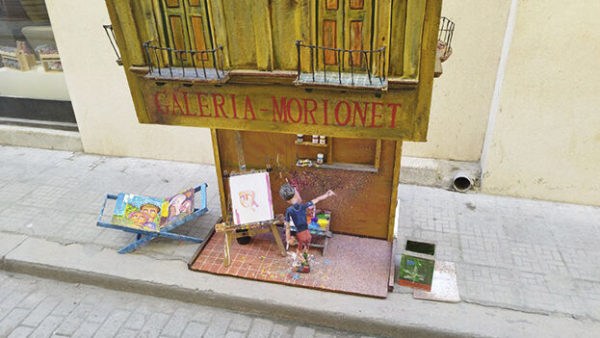Victor, the Puppeteer who Raises a Smile on Cubans Faces
Amid heartbreaking poverty

By Juan Izquierdo/Juan Diego Rodríguez (14ymedio)
HAVANA TIMES – Street Artists, fortune tellers, beggars, Tarot readers, palm readers, wizards, promise-keepers, pickpockets. Old Havana is constantly in turmoil and those who live there have to earn a living by any means possible. Skill, cunning and a ’creole’ type of flair are, in the midst of the general poverty of the country, the only tools available for being able to go home with a bit of money in the pocket.
On Calle Obispo, people push and shove, trying frenetically to make their way about, going in and out of shops, pharmacies, kiosks and snack bars. Then it catches the attention that there’s a group of people who are there to block the way and detain you — under an overhanging roof. And there… you find Víctor, a silent young man, hidden behind the miniature canvas curtains of his Galería Morionet.
Víctor operates the strings of his little puppet theatre — whose name combines that of the painter Claude Monet with the word ’marionette’ — and he makes his puppet, a Cuban skilled like himself, draw a portrait of a man on a piece of cardboard.
It’s a refined skill, and not the kind of skill that can be learnt in a mere couple of weeks. The puppet master pulls on his strings and the puppet shakes his paintbrush, fills it with watercolor and moves towards the easel. Sometimes a dog approaches and the puppet artist looks up at him cautiously, without stopping his work, and then he strokes its nose.
People watch the scene, fascinated. The puppet paints in a messy kind of dump that might be any habanero’s neighborhood, splattered with paint stains and above which hang two unstable-looking balconies. Louis Armstrong’s blues plays in the little room, and, when the music stops, some coins drop into the Galería Morionet’s tray.
Unless they are tourists the passers-by aren’t able to offer much, and, after distracting themselves from their worries for a little while with the show, they have to continue walking on through a city that gets more and more inhospitable. Two police officers eye the youth with suspicion; he carries on with his work without paying them too much attention.
On the sidewalks the waiters of the paladares [private restaurants] spring on the passers-by, interrupting them and unfurling their menus without anyone being able to stop them. None of the habaneros can afford the luxury of dining out in Old Havana, but the waiters have to be seen to be active and charming, in order for the owner, who also must defend his business, to justify their salaries.
Sitting on the sidewalk, a boy, dressed spotlessly in white, offers a card reading. Next to him, water and a cloth on which sits his deck of cards, ready for the next fortune-telling. But nobody stops, and, bored, he stands up to smooth out his clothes, and then resumes sitting.
On another corner a cartoonist draws the portraits of celebrities like Chucho Valdés and Alicia Alonso. Children beg their parents to let him draw them and the man gets to work: back bent over, he holds a board in one hand and with the other he manipulates his ballpoint pen.
Stilt-walkers have also become part of the scenery in the city, especially in groups which roam those streets with more tourists. Noisy and colorfully dressed, these urban artistes hardly manage to get, these days, more than a couple of notes stuffed into their hats — made from remnants and bells — as the fewer number of travelers arriving in the city has left them practically without customers.
Mounted on their wooden stilts they wait on some corner or other for a Transtur coach to discharge its small group of passengers around the Plaza de Armas or the Castillo de la Fuerza. Their show is brief, to avoid the tourists returning to the coach before having left a bit of money, which, amongst all the laughter and song the performers make sure to tell them that “euros or dollars” would be better received “by these particular street artistes”.
Beyond the tourist area the situation takes on sadder tones. It’s not unusual to meet an old lady in a dirty dressing gown begging for money to buy a few pounds of sweet potatoes, or a ’promise-keeper’ dragging a stone tied to his ankle with a chain. As he approaches, as if he were a soul in purgatory, he holds out a bowl for someone to throw in some ’kilos’. The people who watch him, shocked by the marks on his leg, have little to give him.






The image you write in this article sounds very cheerful and at the same time depressing. I love to imagine the joy of the area, people passing by, people taking advantage of their talents and skills to get some money, but it also becomes very dark to imagine the crisis in which they have to complete their day to day life.